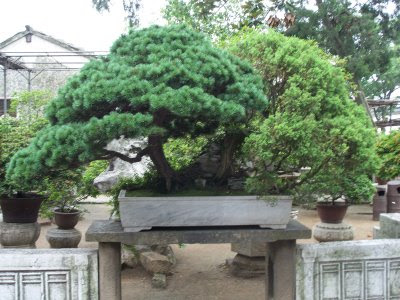
First, there's not as much bamboo as one might think.
And when there is, it is of a common sort, none of the exotic varieties that have proven so popular (and expensive) in the translation of the oriental garden to the west.
That said, one of my favorite spots in the imperial gardens of Beijing--which are altogether more ornate and less tranquil than the scholar gardens of Suzhou--was the above courtyard at the Palace of Prince Gong (such a name!). Four quadrants planted solely with bamboo made for a shady, serene, and atmospheric courtyard, especially when a light breeze rustled the stems.

Chinese gardens can seem overloaded with the grotesque and artificial--with contorted stems and twisted roots and weirdly eroded rocks. But the Chinese affection for these elements isn't simply a penchant for the strange. They look to find in them that which is both familiar and symbolic: the shape of a dragon's claw or a swimming fish or a good luck character. It's similar to cloud-watching, only with the more solid forms of rocks and trees, and implies the meditative contemplation that was to be a part of the garden experience. (Though considering the shenanigans that were gotten up to in many of the historic gardens, the serenity and meditation angle may be overstated!)
The protruding root of this lacebark pine in the imperial garden of the forbidden city is revered for its resemblance to a crouching dragon. Pinus Bungeana is often found as a specimen tree in Chinese gardens, valued for its mottled silvery trunk and referred to as the 'white robed general'.

The Humble Administrator's garden, the largest and most popular of the Suzhou sites, features in one of its pavilions a 'garden history museum', composed of photos faded and curled from the humidity, dusty models, and signage redolent of 1970s central planning. The (poor) photo below--the museum was strangely dim--is the display of 'what flowers and trees imply'

Peony: glorious and noble
Pomegranate: hundred seeds-sons
Lotus flower: purity growing from mud
Osmanthus, magnolia: full of gold and jade
Flowering crabapple: attractive and colorful
Pine and cypress: antiquity and longevity
Wintersweet: high morality in cold
Willow: charming and graceful
Orchid: leisure in tranquility
Red bean: missing and expressing feelings
Bamboo: upright without vulgarism
Narcissus: simple and elegant bearing
Chrysanthemum: sustain frost for integrity
Camellia: natural, unrestrained and elitist

 The use of bonsai is perhaps too obvious to mention, but this one is a Chinese award winner. The bonsai are almost always concentrated in a special area of the garden devoted to their cultivation, not scattered about, which enables them to be easily swept up with a natural twig broom. One of the delights of getting to the gardens of Suzhou early (they open at 7:30 a.m.) is seeing the grounds being brushed and dressed.
The use of bonsai is perhaps too obvious to mention, but this one is a Chinese award winner. The bonsai are almost always concentrated in a special area of the garden devoted to their cultivation, not scattered about, which enables them to be easily swept up with a natural twig broom. One of the delights of getting to the gardens of Suzhou early (they open at 7:30 a.m.) is seeing the grounds being brushed and dressed.Another is seeing young-at-heart Chinese practicing tai-chi in the beautiful surrounds. And, ummm, 'expelling' while they do so.

 In the Chinese garden emphasis is certainly on greenery rather than flowers. In floral material, they tend toward the highlighting of a specific plant type, placing it so that its form and shape are prominently displayed, as in these lotus bowls at the Humble Administrators Garden and the mass lily plantings at Zonghai Park, between Tiananmen and the Forbidden City.
In the Chinese garden emphasis is certainly on greenery rather than flowers. In floral material, they tend toward the highlighting of a specific plant type, placing it so that its form and shape are prominently displayed, as in these lotus bowls at the Humble Administrators Garden and the mass lily plantings at Zonghai Park, between Tiananmen and the Forbidden City.(How much do I want a lotus bowl? Alas, much too big to bring on the plane...)
0 comments:
Post a Comment